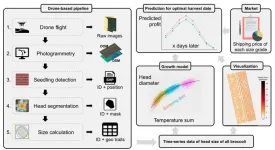(Press-News.org)
For reasons of food security and economic incentive, farmers continuously seek to maximize their marketable crop yields. As plants grow inconsistently, at the time of harvesting, there will inevitably be variations in quality and size of individual crops. Finding the optimal time to harvest is therefore a priority for farmers. A new approach making heavy use of drones and artificial intelligence demonstrably improves this estimation by carefully and accurately analyzing individual crops to assess their likely growth characteristics.
Some optimistic science fiction stories talk about a post-scarcity future, where human needs are catered for and hard labor is provided by machines. There are some ways in which this vision appears to predict some elements of current technological progress. One such area is in agricultural research, where automation has been making an impact. For the first time, researchers, including those from the University of Tokyo, have demonstrated a largely automated system to improve crop yields, which can benefit many and may help pave the way for future systems that could one day harvest crops directly.
“The idea is relatively simple, but the design, implementation and execution is extraordinarily complex,” said Associate Professor Wei Guo from the Laboratory of Field Phenomics. “If farmers know the ideal time to harvest crop fields, they can reduce waste, which is good for them, for consumers and the environment. But optimum harvest times are not an easy thing to predict and ideally require detailed knowledge of each plant; such data would be cost and time prohibitive if people were employed to collect it. This is where the drones come in.”
Guo has a background in both computer science and agricultural science, so is ideally suited to finding ways cutting-edge hardware and software could aid agriculture. He and his team have demonstrated that some low-cost drones with specialized software can image and analyze young plants — broccoli in the case of this study — and accurately predict their expected growth characteristics. The drones carry out the imaging process multiple times and do so without human interaction, meaning the system requires little in terms of labor costs.
“It might surprise some to know that by harvesting a field as little as a day before or after the optimal time could reduce the potential income of that field for the farmer by 3.7% to as much as 20.4%,” said Guo. “But with our system, drones identify and catalog every plant in the field, and their imaging data feeds a model that uses deep learning to produce easy-to-understand visual data for farmers. Given the current relative low costs of drones and computers, a commercial version of this system should be within reach to many farmers.”
The main challenge the team faced was in the image analysis and deep learning aspects. Collecting the image data itself is relatively trivial, but given the way plants move in the wind and how the light changes with time and the seasons, the image data contains a lot of variation that machines often find hard to compensate for. So, when training their system, the team had to invest a huge amount of time labeling various aspects of images the drones might see, in order to help the system learn to correctly identify what it was seeing. The vast data throughput was also challenging — image data was often of the order of trillions of pixels, tens of thousands of times larger than even a high-end smartphone camera.
“I’m inspired to find more ways that plant phenotyping (measuring of plant growth traits) can go from the lab to the field in order to help solve the major problems we face,” said Guo.
###
Journal article: Wang H, Li T, Nishida E, Kato Y, Fukano Y, Guo W. “Drone-Based Harvest Data Prediction Can Reduce On-Farm Food Loss and Improve Farmer Income”. Plant Phenomics 2023;5: Article 0086. https://doi.org/10.34133/plantphenomics.0086
Funding:
This study was partially supported by the Japan Science and Technology Agency (JST) AIP Acceleration Research (JPMJCR21U3) and by the Graduate School of Agricultural and Life Sciences, University of Tokyo “Application for Agricultural Science Emergence Fund.”
Useful links:
Laboratory of Field Phenomics - https://lab.fieldphenomics.com/
Graduate School of Agricultural and Life Sciences - https://www.a.u-tokyo.ac.jp/english/
Research contact:
Associate Professor Wei Guo
Laboratory of Field Phenomics, Graduate School of Agricultural and Life Sciences,
The University of Tokyo, 1-1-1 Yayoi, Bunkyo-ku, Tokyo 113-8657, Japan
guowei@g.ecc.u-tokyo.ac.jp
Press contact:
Mr. Rohan Mehra
Public Relations Group, The University of Tokyo,
7-3-1 Hongo, Bunkyo-ku, Tokyo, 113-8656, Japan
press-releases.adm@gs.mail.u-tokyo.ac.jp
About The University of Tokyo: The University of Tokyo is Japan's leading university and one of the world's top research universities. The vast research output of some 6,000 researchers is published in the world's top journals across the arts and sciences. Our vibrant student body of around 15,000 undergraduate and 15,000 graduate students includes over 4,000 international students. Find out more at www.u-tokyo.ac.jp/en/ or follow us on Twitter at @UTokyo_News_en.
END
A new study published today, analysing wastewater samples from several aged care and retirement homes in Adelaide, has uncovered worrying signs of antimicrobial resistance (AMR) in at least one facility.
High levels of bacterial resistance against three common antibiotics – ceftazidime, cefepime and ciprofloxacin – were identified in one aged care residential home. A second facility recorded above average levels of antimicrobial resistance to gentamicin, putting residents’ health at risk.
The listed antibiotics are used to treat a variety of bacterial infections, including pneumonia, ...
Parrots are exceptional talkers. They can learn new sounds during their entire lives, amassing an almost unlimited vocal repertoire. At the same time, parrots produce calls so they can be individually recognized by members of their flock—raising the question of how their calls can be very variable while also uniquely identifiable. A study on monk parakeets conducted by the Max Planck Institute of Animal Behavior and Museu de Ciències Naturals de Barcelona might have the answer: individuals have a unique tone of voice, known as a voice print, similar to that in humans. This finding in a wild parrot raises the possibility that a voice print ...
Researchers from The University of Queensland and The Alfred hospital in Melbourne have identified gene variants which may contribute to people being at higher risk for nodular melanoma.
Dr Mitchell Stark from UQ’s Frazer Institute said nodular melanoma only accounts for around 14 per cent of invasive melanoma cases, but the aggressive subtype is the largest contributor to melanoma deaths.
“Melanoma is highly curable by surgery when diagnosed early, but nodular melanoma is often detected ...
Public health initiatives to understand and tackle these inequalities should be prioritised, say the researchers.
The aortic valve keeps blood flowing from the heart's lower left chamber (left ventricle) to the aorta—the main artery bringing blood from the heart to the body. Aortic stenosis occurs when the aortic valve narrows as a result of calcium build-up, impeding normal blood flow. This causes shortness of breath, light headedness, and chest pain (angina).
Aortic valve replacement (AVR) not only relieves these symptoms, but increases life expectancy, and improves quality of life, say the researchers, adding that up to 1 in 4 of those with severe or very severe aortic stenosis ...
Information on clinical complications is often missing, while key information on the factors behind medical decision-making, the effectiveness of the lethal drugs used, and the extent of palliative care support isn’t even collected, reveals the review.
Physician assisted suicide as it’s formally known has been legal in the US state of Oregon since 1997 under the Death with Dignity Act.
The legislation allows terminally ill residents over the age of 18 to hasten their death by taking lethal drugs prescribed by a doctor, providing they are capable of making and communicating healthcare ...
A device has been created that could carry out Clinical Breast Examinations (CBE).
The manipulator, designed by a team at the University of Bristol and based at the Bristol Robotics Laboratory, is able to apply very specific forces over a range similar to forces used by human examiners and can detect lumps using sensor technology at larger depths than before.
This could revolutionise how women monitor their breast health by giving them access to safe electronic CBEs, located in easily accessible places, such as pharmacies and health centres, which provide accurate results.
Precision, repeatability and ...
Agriculture in Syria started with a bang 12,800 years ago as a fragmented comet slammed into the Earth’s atmosphere. The explosion and subsequent environmental changes forced hunter-gatherers in the prehistoric settlement of Abu Hureyra to adopt agricultural practices to boost their chances for survival.
That’s the assertion made by an international group of scientists in one of four related research papers, all appearing in the journal Science Open: Airbursts and Cratering Impacts. The papers ...
The the latest data on universal screening for type 1 diabetes (T1D) is reveiwed in a session at this year’s Annual Meeting of the European Association for the Study of Diabetes (EASD) in Hamburg, Germany (2-6 October). The talk will be given by Dr Emily K. Sims, Associate Professor of Pediatrics, Center for Diabetes and Metabolic Diseases, Indiana University School of Medicine, Indianapolis, IN, USA.
Research by various groups has established that individuals with multiple islet autoantibodies (biomarkers showing that the body is attacking and killing its own insulin producing beta cells in ...
New research being presented at this year’s Annual Meeting of The European Association for the Study of Diabetes (EASD), Hamburg (2-6 Oct) finds that cigarette smoking increases the risk of developing type 2 diabetes in part by affecting a variety of metabolites—small chemicals produced in the processes of metabolism—that circulate in the bloodstream.
The influence of these metabolic changes on diabetes risk appears to be amplified in individuals with genetic susceptibility to type 2 diabetes or insulin resistance.
The analysis of over 93,000 UK Biobank participants also identified a metabolic ...
A session at this year’s Annual Meeting of the European Association for the Study of Diabetes will explore the latest data on the concept of metabolically healthy obesity (MHO) – more commonly known by the public as ‘fat but fit’. Professor Matthias Blüher, University of Leipzig, Leipzig and Helmholtz Center Munich, Germany will explain how we define MHO and ask if it can really be described as healthy.
“Some 15-20% of people living with obesity have none ...



